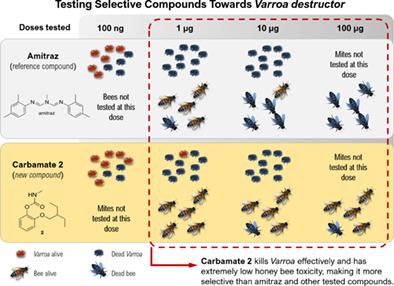当前位置:
X-MOL 学术
›
Pest Manag. Sci.
›
论文详情
Our official English website, www.x-mol.net, welcomes your feedback! (Note: you will need to create a separate account there.)
Testing new compounds for efficacy against Varroa destructor and safety to honey bees (Apis mellifera)
Pest Management Science ( IF 4.1 ) Pub Date : 2021-08-31 , DOI: 10.1002/ps.6617 Cameron J Jack 1 , Kaylin Kleckner 1 , Fabien Demares 2 , Leslie C Rault 3 , Troy D Anderson 3 , Paul R Carlier 4 , Jeffrey R Bloomquist 2 , James D Ellis 1
Pest Management Science ( IF 4.1 ) Pub Date : 2021-08-31 , DOI: 10.1002/ps.6617 Cameron J Jack 1 , Kaylin Kleckner 1 , Fabien Demares 2 , Leslie C Rault 3 , Troy D Anderson 3 , Paul R Carlier 4 , Jeffrey R Bloomquist 2 , James D Ellis 1
Affiliation

|
Varroa destructor is among the greatest threats to honey bee health worldwide. Acaricides used to control Varroa are becoming increasingly ineffective due to resistance issues, prompting the need for new compounds that can be used for control purposes. Ideally, such compounds would exhibit high toxicity to Varroa while maintaining relatively low toxicity to bees and beekeepers. We characterized the lethal concentrations (LC50) of amitraz, matrine, FlyNap®, the experimental carbamates 2-((2-ethylbutyl)thio)phenyl methylcarbamate (1) and 2-(2-ethylbutoxy)phenyl methylcarbamate (2), and dimethoate (positive control) for Varroa using a glass vial assay. The test compounds also were applied to honey bees using an acute contact toxicity assay to determine the adult bee LD50 for each compound.
中文翻译:

测试新化合物对破坏瓦螨的功效和对蜜蜂(Apis mellifera)的安全性
Varroa destructor是全世界蜜蜂健康的最大威胁之一。由于抗药性问题,用于控制瓦螨的杀螨剂变得越来越无效,这促使需要可用于控制目的的新化合物。理想情况下,此类化合物对瓦螨表现出高毒性,同时对蜜蜂和养蜂人保持相对较低的毒性。我们表征了双甲脒、苦参碱、FlyNap®、实验性氨基甲酸酯 2-((2-乙基丁基)硫代)苯基甲基氨基甲酸酯(1)和 2-(2-乙基丁氧基)苯基甲基氨基甲酸酯(2)的致死浓度(LC 50),以及用于Varroa 的乐果(阳性对照)使用玻璃小瓶测定法。还使用急性接触毒性试验将测试化合物施用于蜜蜂,以确定每种化合物的成年蜜蜂 LD 50。
更新日期:2021-08-31
中文翻译:

测试新化合物对破坏瓦螨的功效和对蜜蜂(Apis mellifera)的安全性
Varroa destructor是全世界蜜蜂健康的最大威胁之一。由于抗药性问题,用于控制瓦螨的杀螨剂变得越来越无效,这促使需要可用于控制目的的新化合物。理想情况下,此类化合物对瓦螨表现出高毒性,同时对蜜蜂和养蜂人保持相对较低的毒性。我们表征了双甲脒、苦参碱、FlyNap®、实验性氨基甲酸酯 2-((2-乙基丁基)硫代)苯基甲基氨基甲酸酯(1)和 2-(2-乙基丁氧基)苯基甲基氨基甲酸酯(2)的致死浓度(LC 50),以及用于Varroa 的乐果(阳性对照)使用玻璃小瓶测定法。还使用急性接触毒性试验将测试化合物施用于蜜蜂,以确定每种化合物的成年蜜蜂 LD 50。



























 京公网安备 11010802027423号
京公网安备 11010802027423号